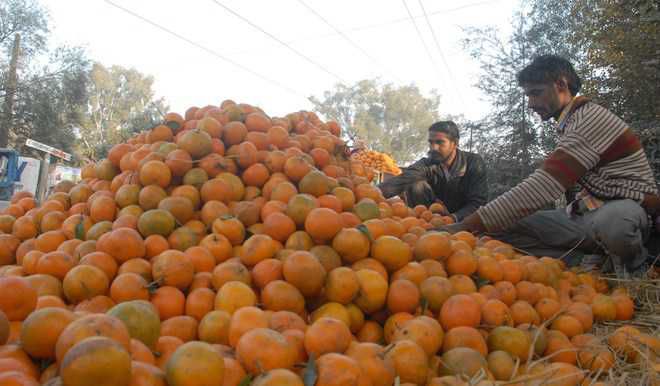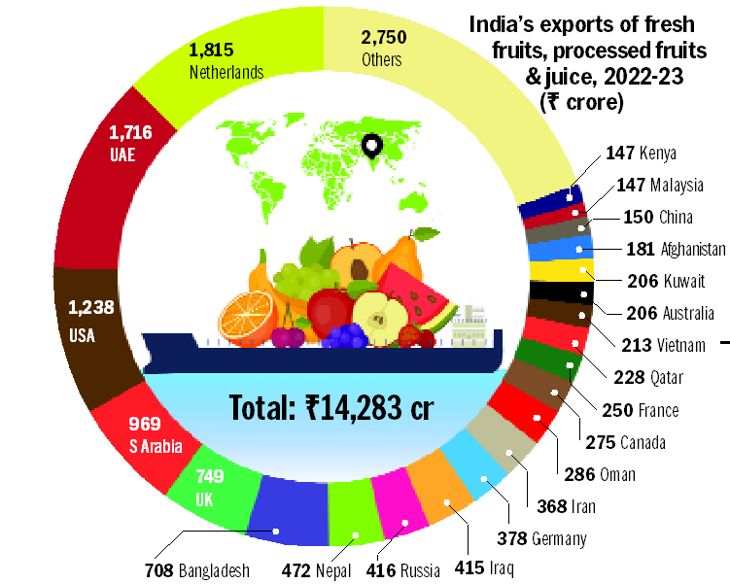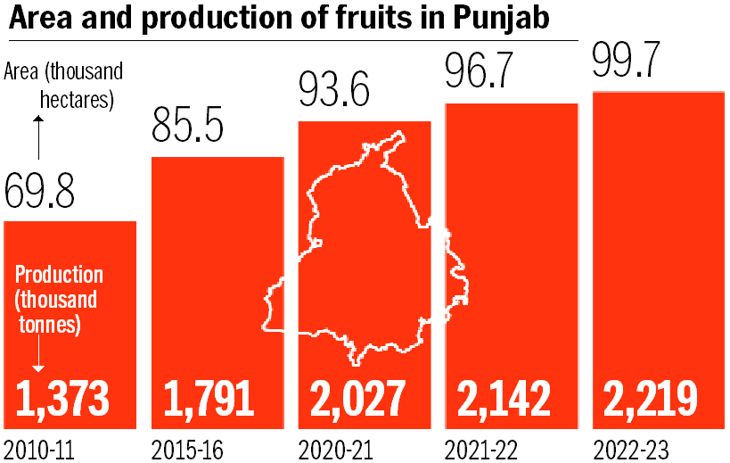
THE most serious problem being faced by Punjab’s agriculture is the alarming depletion of groundwater at the rate of more than half a metre every year due to intensive farming based on the rice-wheat cropping system. - File photo
Baldev Singh Dhillon
THE most serious problem being faced by Punjab’s agriculture is the alarming depletion of groundwater at the rate of more than half a metre every year due to intensive farming based on the rice-wheat cropping system. From 1960-61 to 2022-23, the area under rice (a water-guzzling crop) in the state increased from 2.27 lakh to 31.68 lakh hectares (ha) and that under wheat from 14 lakh to 35.17 lakh ha. These crops replaced a large area under less water-requiring crops like pulses, groundnut, bajra, maize, cotton, rapeseed and mustard. Diversification towards fruit crops is one of the ways to arrest the slide. It will not only help conserve water but also increase farmers’ income and improve nutritional quality. However, fruit plants being perennials, the promotion of their cultivation needs a long-term strategy and action plan, unlike annuals.

Long-term strategy & action plan
Scion and rootstock improvement: The plant performance depends on the combined effect of the scion and the rootstock. The scion improvement has got attention, though less than that in field crops, while the rootstock has been practically neglected. For example, Jatti Khatti is being used as rootstocks for many citrus plants, especially kinnow mandarin, sweet orange, grapefruit, lime and lemon. Guava, pear and ber have only one rootstock and mango has no defined rootstock. Thus, the research on rootstock-scion identification/improvement needs to be intensified. The choice of the rootstock depends on the soil type and health, besides the effects of rootstock, like dwarfing rootstock, on the scion.
Mother plants and nursery: For quality nursery production, the establishment of mother plants under phytosanitary conditions is a must. Mother plants have been established in kinnow for bud wood only. These need to be set up for bud wood as well as rootstock in all important plants.
Public sector institutions must expand containerised nursery production under protected conditions to meet the demand in the state.
Diversity in kinnow and guava: Only one variety of kinnow was under cultivation since its introduction in the 20th century till 2013. In the case of guava, Allahabad Safeda and Sardar are commercially cultivated. Apparently, these crops have extreme genetic uniformity and are highly vulnerable to biotic and abiotic stresses. The nursery production of recently released varieties of kinnow (PAU Kinnow 1, W. Murcott, Daisy) and guava (Punjab apple guava, Punjab Kiran, Punjab Safeda, Shweta, Punjab Pink) should be enhanced for diversification in these crops. Of course, the long-term objective should be diversifying fruit production by bringing more area under crops like pear, mango, litchi, peach and plum.
Germplasm introduction: Kinnow and apples are apt examples. Considering the international order (Convention on Biological Diversity, WTO), germplasm introduction is getting difficult day by day. Therefore, it needs special attention with the objectives of exploiting the exotic germplasm for immediate use and to enrich our gene bank for future needs. Exploitation of varieties identified/developed by institutions outside Punjab, which has taken time in some cases (pomegranate, Bhagwa; guava, Hisar Safeda), should be expedited.
Cultivation practices for diverse agro-ecologies: Punjab has agro-ecologies differing with respect to rainfall and temperature regimes, soil type and fertility, disease, insect pests, etc. Crop cultivation technologies need to be accordingly developed that enable maximal expression of the genetic potential. For example, kinnow is grown in two distinct ecologies, and the recommendations for rootstock and potassium application differ. PAU has developed a bulletin for kinnow cultivation in these ecologies which needs to be refined. Similarly, experimental data need to be generated for other fruit crops.
Canopy alteration and high-density planting: In temperate conditions, the canopy has been altered through pruning and training for high-density planting, streamlining cultural operations and quality production. Research on canopy modifications in mango, jamun, ber, pear/patharnakh, etc. should be stepped up.
Marketing support: This is essential to prevent exploitation of producers. Farmers should be encouraged to form cooperatives, self-help groups and farmer producer organisations and be supplied updated information on the market demand. Also, infrastructure for treatment, packaging, cold storage and transport needs to be developed. Provision of transportation and cold storage to distant domestic markets may be considered on a cost basis. Greater efforts need to be made to tap markets in West and Central Asia. The opening of the land route via the western border will greatly facilitate this trade.
Produce quality and processing: The high-quality produce will enhance its acceptability among consumers. For this, identification of appropriate scions and rootstocks along with optimal use of inputs, particularly pesticides, must be ensured. An important option is integrated pest management based on eco-friendly approaches such as PAU fruit fly trap and HMO oils.
Crop insurance: Fruit crops are sensitive to biotic and abiotic stresses, besides being highly perishable and vulnerable to market volatility. Thus, there is a need to implement crop insurance schemes.
Fruit crops and districts may be covered step-wise as follows:
(i) Kinnow, guava, peach and plum in Fazilka, Pathankot and Hoshiarpur; litchi in Pathankot and Hoshiarpur; and sweet orange in Fazilka; (ii) All crops in Fazilka, Pathankot and Hoshiarpur and adjoining blocks of neighbouring districts; (iii) All crops in the rest of Kandi region and in Ludhiana; pear in Amritsar and Tarn Taran; (iv) All crops in the whole state.
For these efforts to succeed, more estates and food parks/industrial units need to be established and old orchards and senile plants rejuvenated. The expansion of area should be aligned with the ‘one district, one product’ scheme.
The new initiatives must not replace ongoing programmes. Farmers and owners of courtyard gardens should get regular updates on new production and protection technologies, timely provision of quality inputs and their optimal use. Additionally, capacity-building of extension workers, research institutions, researchers and farmers must be strengthened.
The author is a former Vice-Chancellor, Punjab Agricultural University, Ludhiana
Send your feedback to [email protected]
Join Whatsapp Channel of The Tribune for latest updates.



























